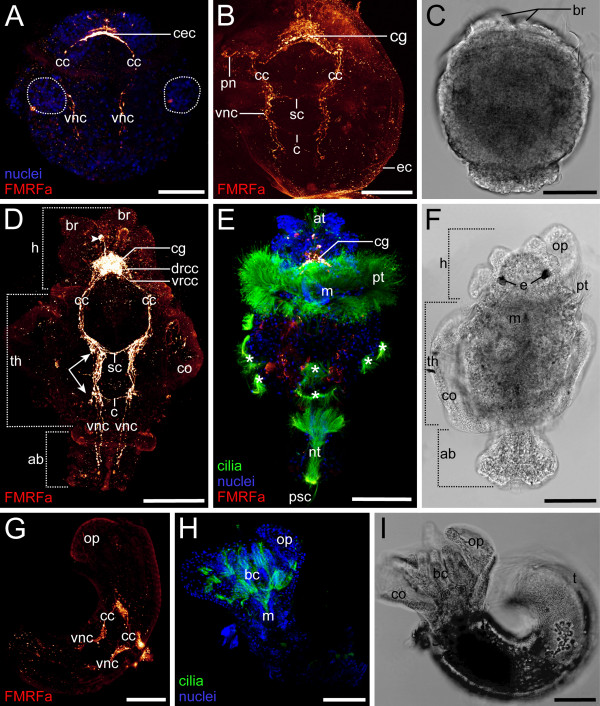Figure 2.
FMRFamidergic neurogenesis in Spirorbiscf. spirorbis. Light micrographs and confocal micrographs showing FMRFamide immunoreactivity (red), nuclei (blue), and cilia (green), anterior faces upwards. Scale bars: 50 μm (A-C); 70 μm (D-I). (A-C) Encapsulated larva, dorsal view. (A) Early anlage of the cerebral commissures (cec), the circumesophageal connectives (cc), and the ventral nerve cords (vnc), together with two lateral cell clusters of the collar rudiments (dashed circles). (B) Still within the egg capsule (ec), the cerebral ganglion (cg), the subesophageal commissure (sc), the neuronal innervation of the prototroch (pn), and a commissure (c) are formed in the early trochophore larva. (C) Anteriorly, the paired branchial rudiments (br) are distinguishable. (D-F) Free-swimming larva, ventral view. (D) Three body regions can be recognized: head (h), thorax (th) with collar (co), and abdomen (ab). The ventral nerve cords (vnc) consist of multiple axons in the collar region (arrows), but only of two axons in the posterior body. Anteriorly, one transitional perikaryon (arrowhead) appears and the circumesophageal connectives split into a dorsal (drcc) and a ventral root (vrcc). (E) The larva possesses an apical tuft (at), a prototroch (pt), a mouth opening (m), a neurotroch (nt), several posterior sensory cilia (psc), and various ciliated fields (asterisks). (F) The operculum (op) starts to form and two pigmented eyes (e) are present. (G-I) Settled juvenile. Dorsal view in G, ventral view of the same specimen in H-I. (G) The FMRFamide expression is restricted to head and thorax. (H) Ciliated bands are reduced to the branchial crown (bc). (I) The direction of the coiled tube (t) has been determined.

